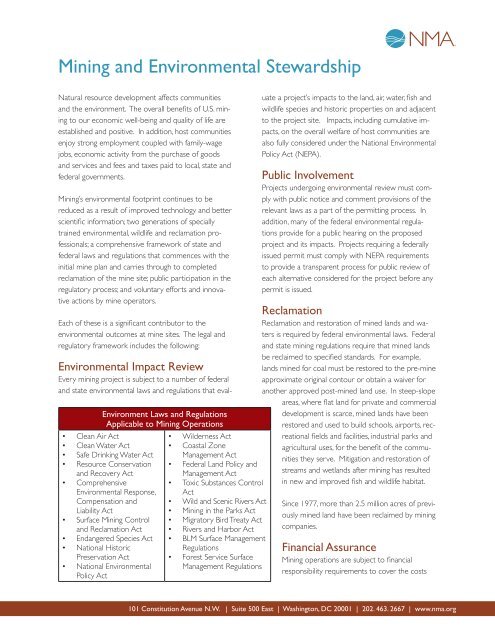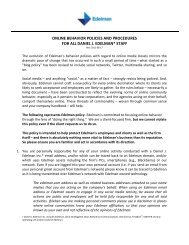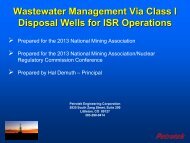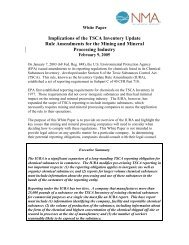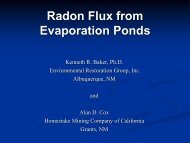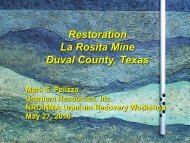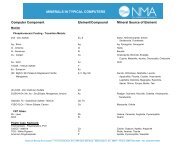Mining and Environmental Stewardship - National Mining Association
Mining and Environmental Stewardship - National Mining Association
Mining and Environmental Stewardship - National Mining Association
Create successful ePaper yourself
Turn your PDF publications into a flip-book with our unique Google optimized e-Paper software.
<strong>Mining</strong> <strong>and</strong> <strong>Environmental</strong> <strong>Stewardship</strong><br />
Natural resource development affects communities<br />
<strong>and</strong> the environment. The overall benefits of U.S. mining<br />
to our economic well-being <strong>and</strong> quality of life are<br />
established <strong>and</strong> positive. In addition, host communities<br />
enjoy strong employment coupled with family-wage<br />
jobs, economic activity from the purchase of goods<br />
<strong>and</strong> services <strong>and</strong> fees <strong>and</strong> taxes paid to local, state <strong>and</strong><br />
federal governments.<br />
<strong>Mining</strong>’s environmental footprint continues to be<br />
reduced as a result of improved technology <strong>and</strong> better<br />
scientific information; two generations of specially<br />
trained environmental, wildlife <strong>and</strong> reclamation professionals;<br />
a comprehensive framework of state <strong>and</strong><br />
federal laws <strong>and</strong> regulations that commences with the<br />
initial mine plan <strong>and</strong> carries through to completed<br />
reclamation of the mine site; public participation in the<br />
regulatory process; <strong>and</strong> voluntary efforts <strong>and</strong> innovative<br />
actions by mine operators.<br />
Each of these is a significant contributor to the<br />
environmental outcomes at mine sites. The legal <strong>and</strong><br />
regulatory framework includes the following:<br />
Environment Laws <strong>and</strong> Regulations<br />
Applicable to <strong>Mining</strong> Operations<br />
• Clean Air Act<br />
• Clean Water Act<br />
• Safe Drinking Water Act<br />
• Resource Conservation<br />
<strong>and</strong> Recovery Act<br />
• Comprehensive<br />
<strong>Environmental</strong> Response,<br />
Compensation <strong>and</strong><br />
Liability Act<br />
• Surface <strong>Mining</strong> Control<br />
<strong>and</strong> Reclamation Act<br />
• Endangered Species Act<br />
• <strong>National</strong> Historic<br />
Preservation Act<br />
• <strong>National</strong> <strong>Environmental</strong><br />
Policy Act<br />
• Wilderness Act<br />
• Coastal Zone<br />
Management Act<br />
• Federal L<strong>and</strong> Policy <strong>and</strong><br />
Management Act<br />
• Toxic Substances Control<br />
Act<br />
• Wild <strong>and</strong> Scenic Rivers Act<br />
• <strong>Mining</strong> in the Parks Act<br />
• Migratory Bird Treaty Act<br />
• Rivers <strong>and</strong> Harbor Act<br />
• BLM Surface Management<br />
Regulations<br />
• Forest Service Surface<br />
Management Regulations<br />
<strong>Environmental</strong> Impact Review<br />
Every mining project is subject to a number of federal<br />
<strong>and</strong> state environmental laws <strong>and</strong> regulations that evaluate<br />
a project’s impacts to the l<strong>and</strong>, air, water, fish <strong>and</strong><br />
wildlife species <strong>and</strong> historic properties on <strong>and</strong> adjacent<br />
to the project site. Impacts, including cumulative impacts,<br />
on the overall welfare of host communities are<br />
also fully considered under the <strong>National</strong> <strong>Environmental</strong><br />
Policy Act (NEPA).<br />
Public Involvement<br />
Projects undergoing environmental review must comply<br />
with public notice <strong>and</strong> comment provisions of the<br />
relevant laws as a part of the permitting process. In<br />
addition, many of the federal environmental regulations<br />
provide for a public hearing on the proposed<br />
project <strong>and</strong> its impacts. Projects requiring a federally<br />
issued permit must comply with NEPA requirements<br />
to provide a transparent process for public review of<br />
each alternative considered for the project before any<br />
permit is issued.<br />
Reclamation<br />
Reclamation <strong>and</strong> restoration of mined l<strong>and</strong>s <strong>and</strong> waters<br />
is required by federal environmental laws. Federal<br />
<strong>and</strong> state mining regulations require that mined l<strong>and</strong>s<br />
be reclaimed to specified st<strong>and</strong>ards. For example,<br />
l<strong>and</strong>s mined for coal must be restored to the pre-mine<br />
approximate original contour or obtain a waiver for<br />
another approved post-mined l<strong>and</strong> use. In steep-slope<br />
areas, where flat l<strong>and</strong> for private <strong>and</strong> commercial<br />
development is scarce, mined l<strong>and</strong>s have been<br />
restored <strong>and</strong> used to build schools, airports, recreational<br />
fields <strong>and</strong> facilities, industrial parks <strong>and</strong><br />
agricultural uses, for the benefit of the communities<br />
they serve. Mitigation <strong>and</strong> restoration of<br />
streams <strong>and</strong> wetl<strong>and</strong>s after mining has resulted<br />
in new <strong>and</strong> improved fish <strong>and</strong> wildlife habitat.<br />
Since 1977, more than 2.5 million acres of previously<br />
mined l<strong>and</strong> have been reclaimed by mining<br />
companies.<br />
Financial Assurance<br />
<strong>Mining</strong> operations are subject to financial<br />
responsibility requirements to cover the costs<br />
101 Constitution Avenue N.W. | Suite 500 East | Washington, DC 20001 | 202. 463. 2667 | www.nma.org
of the approved reclamation plan. Prior to conducting<br />
exploration or operations, mining companies must provide<br />
the appropriate regulatory authority with a financial<br />
assurance mechanism to cover the cost of reclamation<br />
if, for any reason, the company is unable to perform the<br />
reclamation. Generally, the amount of financial assurance<br />
required is calculated to cover the costs of reclamation<br />
if the reclamation were performed by an independent<br />
third party contractor. Financial assurances are reviewed<br />
<strong>and</strong> updated regularly <strong>and</strong> often include funds to cover<br />
construction of treatment facilities <strong>and</strong> long-term water<br />
quality treatment.<br />
Elimination of Legacy Impacts<br />
The mining industry voluntarily undertakes projects<br />
aimed at addressing environmental impacts from historic<br />
or pre-law mining activities. These projects, whether<br />
accomplished independently, or in conjunction with the<br />
governmental entities or local community groups, result in<br />
net environmental benefits including, elimination of high<br />
walls, improved water quality <strong>and</strong> fish <strong>and</strong> wildlife habitat.<br />
101 Constitution Avenue N.W. | Suite 500 East | Washington, DC 20001 | 202. 463. 2667 | www.nma.org


